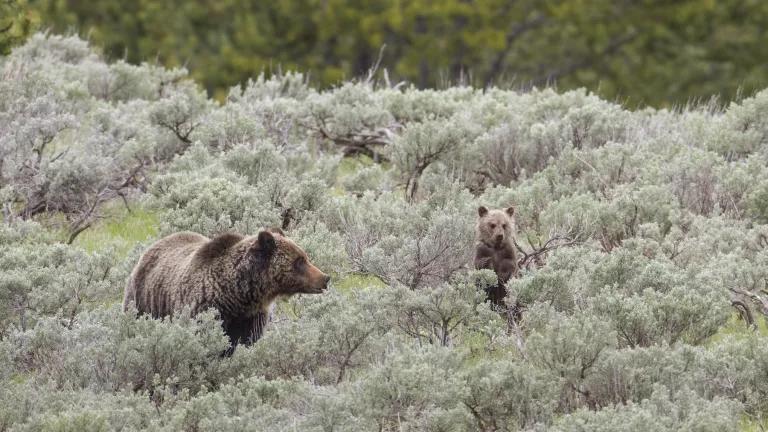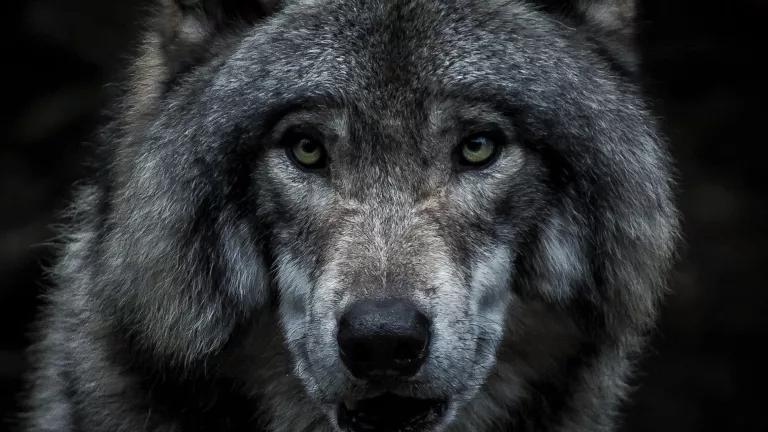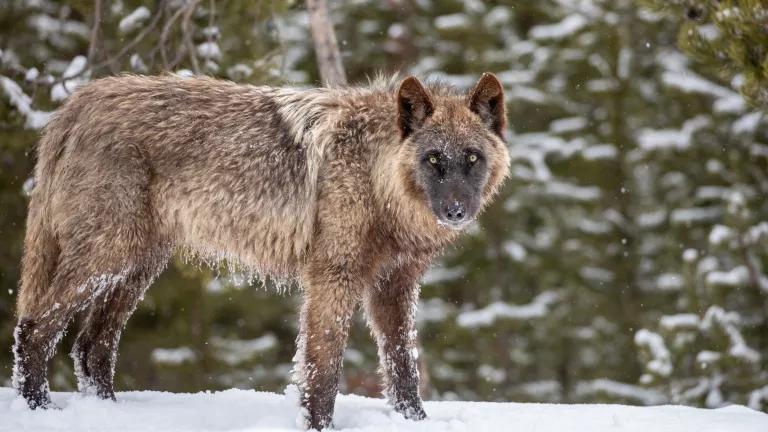Breaking the Cycle: Getting Ahead of Carnivore Conflicts
In 2018, the partnership between Wildlife Services, NRDC, Defenders of Wildlife, and other conservation organizations has helped to fund, develop, and implement numerous nonlethal predator control projects across the northwestern United States.

Upper: A line of newly installed fladry. Lower: Camera trap footage of a wolf walking along this line of fladry before deciding not to cross over the ‘barrier.’
Photo: Wildlife Services
Beginning in 2015, my colleague Zack Strong began testing the waters of collaboration with the federal agency Wildlife Services. As a result, Montana Wildlife Services and NRDC started working together for the first time to try to prevent conflicts between carnivores and people—such as wolves preying on cattle, bears raiding honeybee hives, and mountain lions killing goats. The partnership began with both parties dipping a cautious toe into the water, and, as I’ve learned in my first month working with NRDC, the pool is surprisingly pleasant today. In the nearly three years of partnership, Montana Wildlife Services has been an innovative and proactive partner in working to increase opportunities for nonlethal conflict prevention work, which has benefited communities and wildlife across the state.
Finding solutions for managing human-carnivore conflicts is more timely than ever as animals like grizzly bears slowly rebound and continue to expand across agricultural lands in Montana. Anticipating future conflict, taking steps to protect both wildlife and livestock, and promoting coexistence between people and carnivores have become the common ground for NRDC, Wildlife Services, and new partners as we work together towards progress, despite our differences.
There have continued to be exciting new developments in the story since the first two years of the partnership. Interest in proactive conflict prevention work has grown inside Montana and has also spread to new states, with more and more producers expressing an interest in trying different approaches, like turbo fladry—an electrified wire with hanging flags that deters wolves from accessing livestock enclosures.
In 2018, the partnership between Wildlife Services, NRDC, Defenders of Wildlife, and other conservation organizations has helped to fund, develop and implement numerous projects across the northwestern U.S. Just in Montana, those efforts have included:
- More than six miles of fladry hung around six livestock pastures;
- Permanent electric fencing installed to protect livestock and property across nine sites;
- Nine permanent and semi-permanent electric barriers around honeybee yards (with an additional five barriers planned for September 2018); and
- A new range rider program in the northwestern corner of the state.
Instrumental to making these projects possible has been a collaboration between Wildlife Services and NRDC (with significant help and support from Defenders of Wildlife and The Vital Ground Foundation) to hire two new positions dedicated exclusively to non-lethal conflict prevention and coexistence work: a ‘wildlife conflict prevention technician’ (focused on electric fencing projects) and a range rider. These roles are the first of their kind for Wildlife Services across the whole country. The fencing projects listed above are a testament to the hard work of Adam Baca, who filled the fencing technician position for Wildlife Services. Adam now works full time to implement a range of conflict prevention strategies and to provide information about non-lethal options to landowners and livestock producers. He explained of his new role:
"What specifically attracted me to the position is the whole idea that it’s on the forefront of carnivore management techniques for trying to figure out what new ways we can help producers and carnivores share the landscape."

Adam Baca of Wildlife Services preparing to install electric fencing in Montana.
In northwestern Montana, the new range rider hired by Wildlife Services has been working with ranchers and their cattle to minimize interactions between livestock, wolves, and grizzly bears on summer rangelands and grazing allotments. These expanses of land are too vast for electric fencing to be useful, but the presence of the rider helps to deter carnivore activity around the livestock monitoring area. By visiting the remote grazing allotments on horseback multiple times each week, the rider has been able to keep track of recent carnivore activity, monitor the cattle, and report any carcasses discovered.

A diversity of local wildlife documented by the range rider using camera traps. Upper left: a black bear; upper right: a bobcat; lower left: a wolf; lower right: a moose.
In the most recent on-the-ground fencing project, I joined Adam and NRDC’s field technician Josh Ross to help construct an electric fence around a honeybee yard north of Bozeman, Montana. The bee keeper hadn’t experienced any bear raids yet, but he saw the damage caused when black bears raided neighboring beehives and decided to take a proactive approach to ensure his hives wouldn’t be next. He also recognized that his hives were stationed near an important wildlife corridor along the Gallatin River—an area frequented by bears.

Electric fencing around beehives near the Gallatin River.
Conflicts between humans and carnivores are nothing new: carnivores have caused damage, and humans have responded by killing carnivores, ever since Europeans first began settling in the West. This trend has continued into modern times, often resulting in unfortunate cycles that leave everyone on the losing end—agricultural producers, management agencies, and wildlife enthusiasts alike.
But our collective toolkit is rapidly expanding, and Wildlife Service’s new conflict prevention positions in Montana have enabled a dramatic increase in our efforts to get ahead of conflicts. New opportunities for preventing loss and conflict are vast. Initiating proactive and preventive strategies in Montana is helping to forge a new type of landscape where people, livestock, and native carnivores can coexist more peacefully. With plenty more projects planned for the coming months across Montana, Wildlife Services’ conflict prevention technician will have his hands full, but NRDC and other conservation partners will be there to help share the load.

Collaborating to build an electric fence around beehives. From left to right: Glenn Colclough, Jennifer Sherry, Josh Ross, and Adam Baca.



